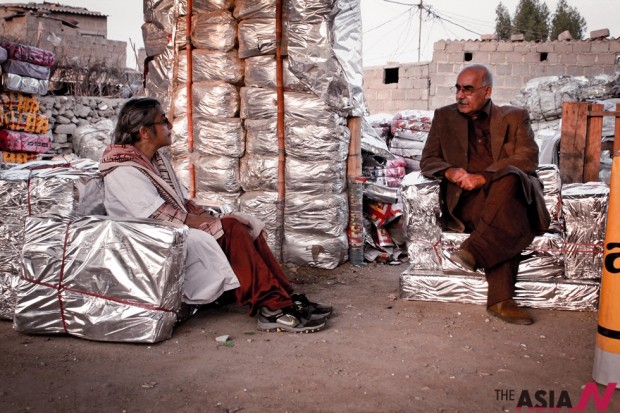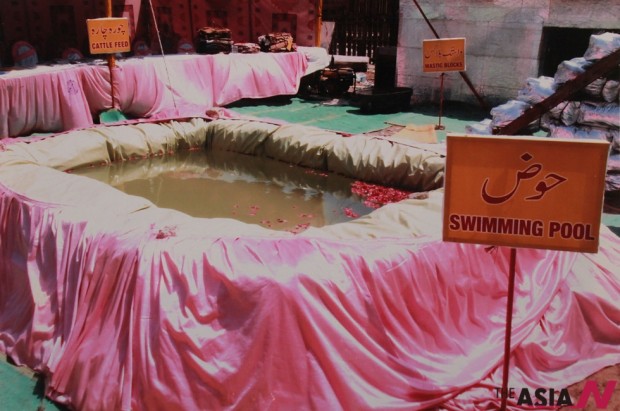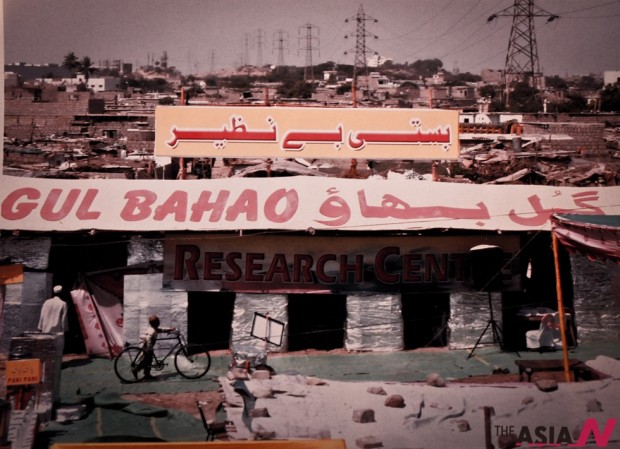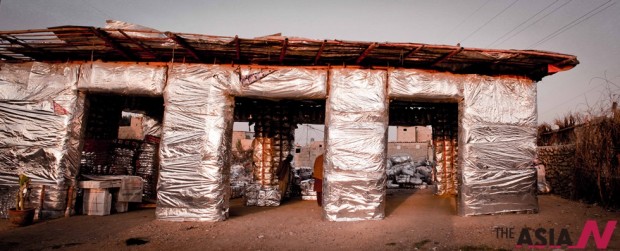Gold for garbage: Innovative way of waste management

Nasir Aijaz with Ms. Nargis Latif, CEO of Gul Bahao, at her research center sitting on chairs made of waste-blocks (Photo: Rahul Aijaz)
Twenty years back people laughed at Ms. Nargis Latif, who hails from a well-off family of Karachi, when she started collecting municipal waste for recycling and propagated the slogan “waste for gold” as an idea aimed to create self-employment opportunities and get rid of environmental problems.
Even though she did not get a positive response at the outset from either a government authority or from the general public, she continued her efforts persistently to create awareness and mould the minds of the people. She started investing from her own pocket on research and producing various products to prove the usefulness of the seemingly useless garbage. Now the situation is totally different, as the citizens as well as the government authorities, educational institutions and corporate sector have started responding and taking her idea seriously. The universities and other institutions of higher education are now inviting her to deliver lectures on waste management. The national as well as international media has also given wide coverage of her research center and products made there.
“Over the years I have invested around 90,000 dollars from my own pocket and other sources including the sale of waste-made products,” Nargis, Chief Executive of Gul Bahao, told Magazine N.
“The port city of Karachi, having 20 million souls, is the 6th most populated metropolis in the world generating more than 12,000 tons of garbage in a single day. In addition, its economic wealth at this point in time (which is seeing rapid industrialization) makes it an ideal case study for waste management. My organization named Gul Bahao (Flow the Flowers), has succeeded in covering several aspects of waste management from extremely small and simple but highly effective products like mobile toilets to a most sophisticated futuristic concept like the ‘Garbage n Gold Bank’.”
It has dwelt into multiple dimensions of waste management. A massive campaign called “You give us garbage, we will give you gold” was conducted for more than 2 years where inter alia invited people, especially from the vibrant cottage industry and the informal economy, to separate garbage at source.
The philosophy of Gul Bahao is that there is a close nexus between the environment and the economy and that garbage is in fact a raw material for both the industry and agriculture. The organization conducts research at its center on both the macro and micro levels.
Plastic packing material forms a bulk of inorganic waste. The world over waste material is being used creatively, but more for decoration purposes. At the center, the researched products are commercially viable products like cattle feed and Instant Compost Fuel Packs. Furniture is also being made from packing material. The world famous “silver block,” a modular block designed at the center, is used alternately as a swimming pool, and also for building two-story houses, etc. The raw material used is plastic waste, which is otherwise burnt in the streets of Karachi causing toxic fumes and severe air pollution. The usefulness of these recycled products ensures that their raw material will not be mixed up with other kinds of organic waste.
As a result of Gul Bahao’s persistence in advocating the recycling of sewerage water, two important steps were taken by the government of the day. One of these was a ban on using fresh water in lawns and encouraging the use of gutter water in horticulture so that fresh water is not polluted by sewage water.
You give us garbage, we give you gold
This led to a healthy growth of nurseries using gutter water. Secondly, during the time of sacrifices of animals, the offal and other organic waste used to be lying around for days in the streets. But, a proposal from the research center to the local governments to bury the entrails and other filth of the dead animals en mass lead to a complete change in the situation.
Thousands of people consisting of university students, NGO workers, government officials and school children as well as the media have visited the research center. Its website is often visited and even used for writing research papers by students. Taking a step further, the organization is now offering paid internships to young people.
Nargis, who had returned from Nepal after attending an international conference on sanitation, said: “We are all conscious of the fact that environment degradation cannot be allowed to go unchecked. Calling for the stopping of industrialization and development due to environmental pollution is not a workable solution. The answer to such problems lies in conducting research with different kinds of materials being thrown up by industries and humans.”
“The time has now come for the world community to avail the fruits of this research facility located in Karachi,” she said.
The research center had organized an exhibition in mid 2013 displaying several waste-made products including the hanging garden with flower pots made of waste, Chaandi Ghar (silver house) made of blocks (panels) prepared from waste and wrapped in silver colored aluminum foil. The roof of silver houses is made of bamboo sticks and plastic sheets. A room built by this waste material hardly costs 350 dollars. During the devastating earthquake in the northern areas in 2005 and the floods in 2010-11 in some provinces of Pakistan, Gul Bahao donated such houses for displaced families. More recently, the organization has started manufacturing pre-fabricated roofs.

A view of a small swimming pool. This pond made of waste could also be used for fish farming. (Photo: Rahul Aijaz)
Fruits of Gul Bahao’s research
A large number of people have started earning their livelihood from waste collection as an organized business. The collection of waste material is not a new idea, as before the launching of this project by Nargis Latif, there used to be a number of Kabaris (scrap dealers) across the country who engaged people in collecting pieces of metal, plastic, glass bottles and other such things, which they used to sell to recycling industries. After the influx of about three million Afghan refugees during the late 1970s, a large number of poor Afghan refugees including their kids chose to earn their livelihood as scavengers.
These rag pickers lifted pieces of metal, plastic waste material, plastic bags and paper from the garbage dumping sites and sold them to Kabaris. These Afghans are still seen at garbage dumping sites and they are becoming a big source of the thriving business of scrap dealers. Besides Afghan refugees, the poor Saraiki-speaking people of Punjab province have also got engaged in scrap collection. In almost every locality, these people can be seen with pushcarts roaming the streets to buy old and useless material to sell to Kabaris.

A view of raw material (waste) collected from different industries of Karachi, the port city of Pakistan (Photo: Rahul Aijaz)
However, the change brought by Gul Bahao is that the people, who had never thought of collecting municipal waste, are now doing this as a business. They have purchased vehicles to collect the waste by visiting door to door. This profession gives them dual benefits – they charge Rs.200 (2 dollars) from each house on a monthly basis while the waste collected is sold to Gul Bahao or other dealers. The citizens have no other option but to pay them, as the civic bodies of Pakistan have miserably failed to collect the waste from cities and towns.
When Gul Bahao first launched the campaign offering gold for municipal waste to motivate the people, it looked like a strange idea, but now the people engaged in this business are earning gold in a real sense for being in a profitable profession.































































